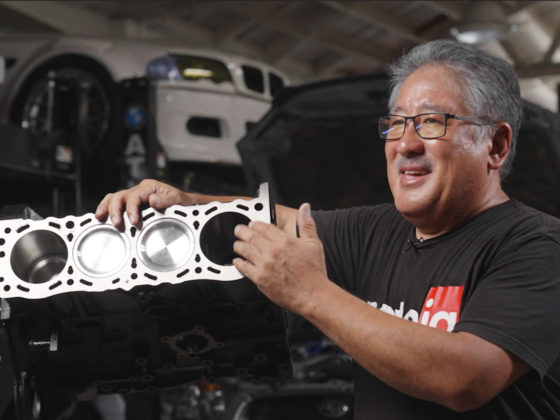There are many reasons why relocating the battery should be one of the first modifications done to an RX-7. First off, electronics hate heat and there aren’t many engine bays that get hotter than one with a rotary engine. Batteries will last longer and the car will start more reliably if it is not heat soaked in the engine bay. Secondly, moving a heavy battery from the front of the car to the middle or rear will improve the car’s weight distribution, steering response, handling, and grip. It also removes a bottleneck behind the radiator to improve airflow as well as allow for more room in the engine bay for cooling upgrades like a bigger intercooler.
Rotaries are not the easiest engines so start, so it is crucial to use a battery with enough cranking amps and properly sized battery cables. We reached out to AntiGravity Batteries, MeleDesign Firm, and Battery Cables USA to come up with the ultimate battery relocation solution for the FD RX-7.

AntiGravity Batteries are revolutionizing the industry with proven, reliable lithium-ion batteries. Since RX-7s put a lot of load on a battery when starting, the compact ATX-30-HD was recommended for our application. The Heavy-Duty series of batteries are designed with more capacity (+6 amp hours), offer a deeper level of discharge, and more power for cranking than the standard ATX30. There is also a built-in Battery Management System (BMS) that protects the battery from over-charging and discharging in additional to thermal protections that make AntiGravity batteries some of the safest and longest life-cycle lithium-ion batteries in the market. We are pairing this battery with CTEK’s Lithium-Ion Charger for when the car sits for long periods of time when we do the next major mods.
 The ATX-30-HD features an impressive 970 cranking amps, 48 Ah (amp hours) of capacity, and weighs in at a featherweight 7.8lbs. By comparison, the lead-acid Group 35 battery we are replacing has similar amp hour capacity, but only 63% of the cranking amps (615 CA), and weighs over 30lbs more (38lbs).
The ATX-30-HD features an impressive 970 cranking amps, 48 Ah (amp hours) of capacity, and weighs in at a featherweight 7.8lbs. By comparison, the lead-acid Group 35 battery we are replacing has similar amp hour capacity, but only 63% of the cranking amps (615 CA), and weighs over 30lbs more (38lbs).
Miata batteries are also popular alternatives for FD RX-7s, but they have even less cranking amps (450 CA), less capacity (25 Ah) and weigh 24.5lbs. The Odyssey PC680 racing battery is another common option, but it only has 540 cranking amps for 5 seconds, 16 Ah of capacity, and weighs 16lbs. For these reasons, the Miata and PC680 batteries are just not enough for anything short of a racecar with no stereo that lives on a trickle charger.
 MeleDesign Firm is making a name for themselves in the rally world with their extremely well-engineered and high-quality battery boxes and mounts. Made from 5052 alloy for its strength and ability to be shaped without fracturing, their mounts include mounting hardware and are used by many professional race teams in North America.
MeleDesign Firm is making a name for themselves in the rally world with their extremely well-engineered and high-quality battery boxes and mounts. Made from 5052 alloy for its strength and ability to be shaped without fracturing, their mounts include mounting hardware and are used by many professional race teams in North America.
 Each battery mount is serialized for authenticity and quality control and lined with foam for vibration isolation. A quick-release pin secures the battery in place and makes for quick and easy removal of the battery when needed.
Each battery mount is serialized for authenticity and quality control and lined with foam for vibration isolation. A quick-release pin secures the battery in place and makes for quick and easy removal of the battery when needed.




12 comments
Great article. JP3 Motorsports makes a nice mount for the fuse block so it’s not zip tied or flopping around in the engine bay.
https://jp3motorsports.com/collections/mazda-fd3s/products/mazda-rx7-fd3s-battery-fuse-block-bracket-relocated-batteries
Awesome update. You always do such quality work. I can’t wait for the next one.
Didn’t see a fuse for the fuel pump at first glance (page 5, 1st pic ) Then I looked again.
FYI Lots of motorsports guys complain about those circuit breakers… they say they have had them vibrate open during operation. I’m running 2 on my car and haven’t had an issue yet.
I know that this is going to sound crazy, but recently I had a family member’s car serpentine belt fail and it ended up damaging the pulley. I was not able to source a new pulley in the location it was in, so we decided to try and run the car as long as possible without the serpentine belt (thus sans alternator, power steering, and AC). Fortunately, the battery was almost brand new and fully charged.
Interestingly enough, the car started and ran well for the 10 mile trip home! No issues whatsoever.
This makes me think that you could conceivably run a time attack car with the alternator removed!
Yes, this is totally crazy, but ‘racecar’, right?
Not only would you save a significant amount of weight, but you would reduce parasitic losses on the drivetrain. With a powerful enough lithium-ion battery, I am sure that you would have no issues running like this for one-lap.
Anyway, food for thought.
That is very common in SCCA sprint racing, especially in the smaller bore Prod and GT classes.
I don’t know about a modern racecar with all the electrical load. Our time attack car draws over 140 amps when everything is going full ti;t.
Was your classic to engine 2awg black ground wire able to reach north bolt holes with slack? Mine is very very tight and will not even bolt up
I think we relocated it to the 13mm bolt just below the brake master cylinder.
I have the same problem. The cable that comes with the kit is NOT long enough. Mine even came in a little bit longer at 16in. Pretty disappointing, gonna have to order another cable.
Yep, 15 inch is just barely too short in my set up (using Banzai motor mounts). Had to order a 17 inch cable, although 16 inch probably would have been ok.
What do you do if you don’t want to remove the Electrical harness and take out the old power and ground cables? Would like to leave them in there so it can be put back to original. Thank you
Would look nice with the JP3 Fuse Block Bracket.